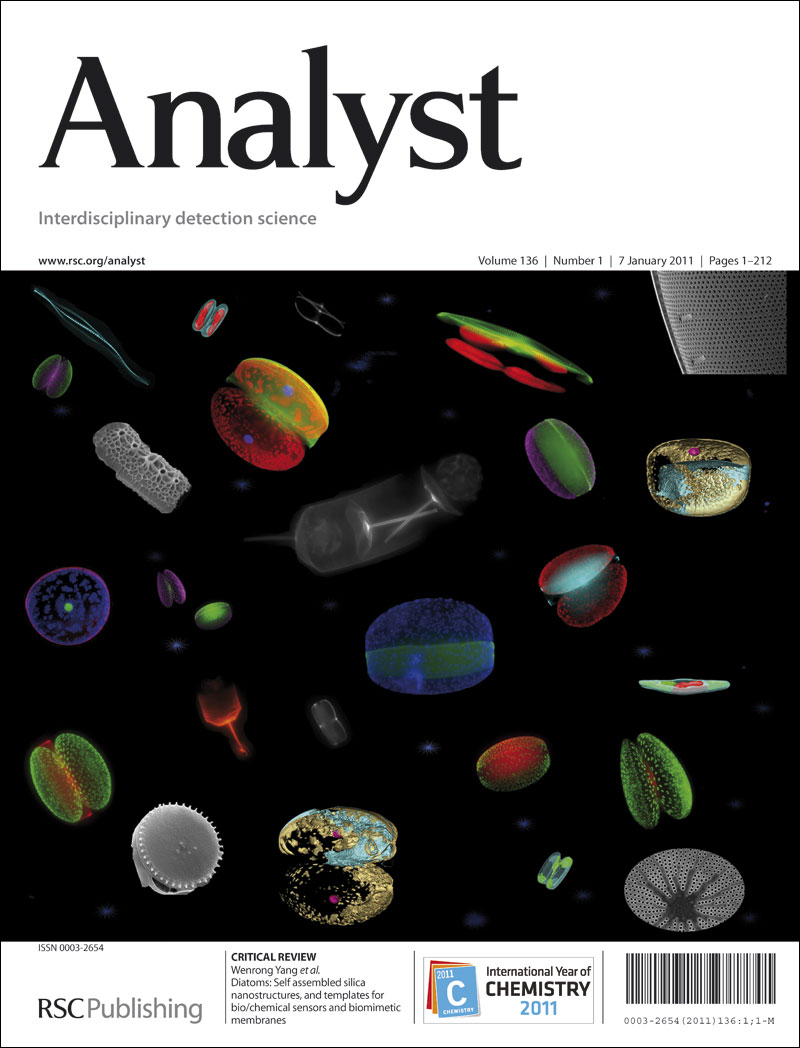金纳米粒子/纤维素纳米纤维复合膜用于纹身型生物传感器
IF 3.3
3区 化学
Q2 CHEMISTRY, ANALYTICAL
引用次数: 0
摘要
薄膜技术对可穿戴设备的发展至关重要。金属层,如铬和镍,可以在衬底上形成使用传统的沉积技术,包括溅射和气相沉积。然而,稳定性和生物相容性问题限制了它们在可穿戴设备中的应用。这包括由于腐蚀和金属过敏的发展而导致的导电性恶化。此外,薄膜由于缺乏柔韧性,在形状变化时容易开裂和剥落。为了解决这些问题,我们利用纤维素纳米纤维(CNFs)和金纳米颗粒(AuNPs)来制造一种新的导电复合薄膜。纤维素纳米纤维具有轻质、高强度和优异的柔韧性,而金纳米颗粒具有化学稳定性和生物相容性。由于AuNP和CNF在混合溶液中自发结合,因此很容易通过过滤形成AuNP/CNF膜。AuNP/CNF薄膜电极在K3[Fe(CN)6]溶液中表现出典型的电流响应(峰值分离= 73 mV),其电极性能与金极板几乎相同。将葡萄糖氧化酶固定在AuNP/CNF膜上的酶修饰电极表现出良好的浓度依赖性(检出限:Michaelis-Menten常数估计为5.2±0.2 mM。AuNP/CNF薄膜具有优异的导电性和灵活性,当附着在皮肤上时可以实时监测电流响应,表明其作为可穿戴设备和智能纺织品的柔性传感器电极的潜力。本文章由计算机程序翻译,如有差异,请以英文原文为准。
Gold Nanoparticle/Cellulose Nanofiber Composite Film for Tattoo-Type Biosensor
Thin-film technology is important for the development of wearable devices. Layers of metals, such as chromium and nickel, can be formed on a substrate using conventional deposition techniques, including sputtering and vapor deposition. However, stability and biocompatibility issues have limited their application in wearable devices. This includes the deterioration of electrical conductivity due to corrosion and development of metal allergies. Furthermore, thin films are prone to cracking and peeling in response to shape changes owing to their lack of flexibility. To address these issues, we utilized cellulose nanofibers (CNFs), which exhibit lightweight, high strength, and excellent flexibility, and gold nanoparticles (AuNPs), which are chemically stable and biocompatible, to fabricate a new conductive composite film. Because AuNPs and CNFs spontaneously combine in a mixed solution, the AuNP/CNF film was easily formed by filtration. The AuNP/CNF film electrode demonstrated almost the same electrode properties as a gold plate, exhibiting a typical current response (peak separation = 73 mV) in K3[Fe(CN)6] solution. The enzyme-modified electrode, with glucose oxidase immobilized on the AuNP/CNF film, showed good concentration dependence (detection limit: 0.010 mM) in the glucose concentration range of 0.010–20 mM. The Michaelis–Menten constant was estimated to be 5.2 ± 0.2 mM. The AuNP/CNF film exhibited excellent conductivity and flexibility, allowing real-time monitoring of electrical current response when attached to the skin, suggesting its potential as a flexible sensor electrode for wearable devices and smart textiles.
求助全文
通过发布文献求助,成功后即可免费获取论文全文。
去求助
来源期刊

Analyst
化学-分析化学
CiteScore
7.80
自引率
4.80%
发文量
636
审稿时长
1.9 months
期刊介绍:
"Analyst" journal is the home of premier fundamental discoveries, inventions and applications in the analytical and bioanalytical sciences.
 求助内容:
求助内容: 应助结果提醒方式:
应助结果提醒方式:


